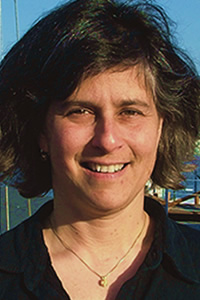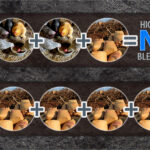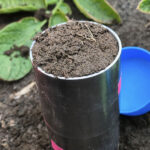
Sally Brown
BioCycle December 2015
As you can imagine, I was very excited when one of my neighbors (a nurse) told me about a new medical procedure that he referred to as a “transpoosion.” The procedure is used for cases of bacterial infection such as cryptosporidium that are often unresponsive to traditional courses of antibiotics. Fecal matter from a healthy individual is given to repopulate the intestines of the infected individual. Typically, the gastro intestinal ailment that has been wearing the infected person down for months is gone within a day or two. The official name for this is a fecal transplant.
Now I love this for several reasons. First, I love painful puns, i.e., transpoosion. The most important and the serious reason that I find this exciting is that this approach represents a new paradigm, one that has applications to organic residuals. Our way of healing and growing food for the last several generations has been to kill things. Our dependence on antibiotics for healthcare and agricultural chemicals for farming are the two examples that come to mind. Antibiotics kill the bad with the good, as do the range of agricultural chemicals that include the term “cide.” Just look at the names — antibiotics means anti biological life and cides (pesticides, herbicides) means death.
That tells it all. Don’t get me wrong; antibiotics have saved countless lives. Agricultural chemicals also have a role in farming. For both, one of the issues with them is that they have been so effective that they are now typically over used and so are losing their effectiveness.
Adding More Life
The approach with fecal transplants is a move in the opposite direction. Instead of killing all life, we are seeing an approach where adding more life — in the form of healthy bacterial cells — is being used to get rid of the bad guys. This approach strengthens the good guys and uses them to overwhelm the bad. It comes at a time when we are applying newly developed tools to analyze the populations of organisms that live within us — our human microbiome. You can read about how what you eat changes your microbiome. You can take heart from overeating this holiday season in the knowledge that you are also nourishing the over 10,000 types of bacteria, fungi and archaea that you share your body with. Your body is home to many pounds of microbial guests that are likely more important to your general well being than your actual family.
The same approach works for soils and agricultural systems. Here by composting the leftovers or using the biosolids generated from Thanksgiving and holiday feasts, you can start regenerating and rebuilding your soil microbial community. It may not look like turkey to you, but it is exactly the spread they need to flourish.
I heard an inspiring example of just how effective this approach can be at the Washington Organic Recycling Conference, held in November in Wenatchee, Washington. The theme of the conference was “Feed the Soil, Feed the World.” Brendon Rockey from Rockey Farms in Center, Colorado (www.soilguys.com) was the speaker that really did it for me. He is a third generation potato farmer who was starting to see that the “anti” approach for farming was killing a lot more than the potato beetles. Rockey described how conventional farming — synthetic fertilizers, pesticides and herbicides and monoculture cropping — was starting to turn into a self perpetuating spiral, requiring more “anti” inputs, destroying his soil microbial community and structure. This in turn resulted in the need for more irrigation water. After years of this approach, demand for chemical inputs increased and potato yields had started to decrease.
Pro Biotic Farming
Rockey noted the roots of different words (fitting approach for a potato farmer and yes, potatoes are not technically roots, they are tubers). For example, pesticides and herbicides and nematocides all have the common “cide” that literally means a person or substance that kills (think homicide). He explained his realization that this dependence on killing was antithetical to his role as a farmer, which is to nurture the soil and grow food. As a result of this realization, Rockey has substituted a pro biotic (here literally relating to or resulting from living things) approach and does not miss his years of working with “cides.” He credits much of this approach to his uncle, who was trained as a rocket scientist, but was also able to look to the ground. His uncle started working to encourage life in the soils in the 1990s and that approach has gotten more sophisticated and successful over time.
The transition to a pro biotic approach to farming started with compost made from cattle and hog manure. Composts were added to his soils to bring back the microbial community, and to increase organic matter, thereby improving soil structure. The compost was just a first step, albeit a critical one. Since the first application of compost, Rockey’s approach has gotten more complex and his need for compost has gone down. While he still adds compost to his fields, it is now applied at 1 to 2 tons/acre rather than the initial 3 to 5 tons/acre.
So what does growing potatoes look like at Rockey Farms? At this point instead of a monoculture supported by a range of chemical inputs, his farm is a complex system that supports life by enriching it. Here life refers to both the organisms living in the soil and the plants growing in the soil. Potatoes are grown in combination with legumes and other plants (buckwheat is one example). They are planted together in the same rows at the same time. Companion cropping is the term for this approach. It does not complicate harvests or increase demand for water and other inputs. Rather the reverse has been true. In between the potatoes are rows of plant mixtures intended to draw beneficial insects. The beneficial insects and soil organisms outcompete or eat the bad ones, essentially eliminating the need for “cides.”
This transition to diversified agriculture with an emphasis on the understanding of living systems to achieve a healthy soil and plant community has made the farming operation more profitable. Input costs are lower and yields have remained good, if not increased. Rockey is using much less water as the soil structure has improved, and water is now held efficiently in the root zone. Fertilizer use is drastically reduced because of compost utilization and companion planting with legumes. This approach is starting to draw attention and converts.
In medicine and in agriculture, we are beginning to recognize that we are not working in isolation. In both cases, we depend on and are part of a complex system that helps to support and nourish all life, not just ours and the potatoes. This is a very different paradigm from our reliance on weapons of mass destruction both in our bodies and in our fields. It gives me cause for optimism. So happy holidays and let’s celebrate and take pride in helping to nourish this complex web that we are a part of.
Sally Brown is a Research Associate Professor at the University of Washington in Seattle and a member of BioCycle’s Editorial Board.









